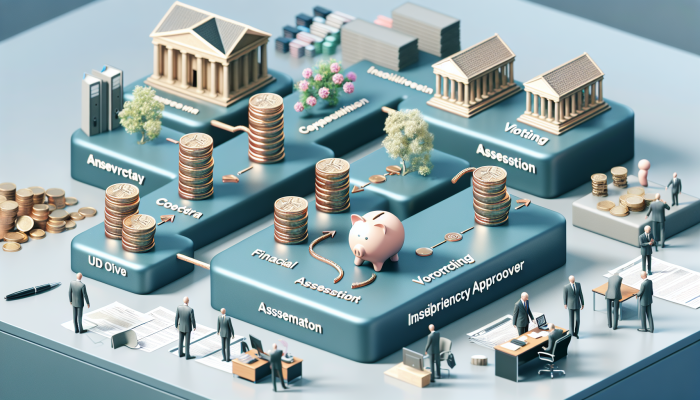Comprehensive Guide to Mastering Your Debt Management Plans
Essential Elements for Crafting a Successful Debt Management Plan

The notion of a Debt Management Plan (DMP) is a crucial strategy designed to assist individuals in effectively managing their debt. This strategic framework concentrates on merging multiple debts into a single, manageable monthly payment, typically featuring significantly lower interest rates. The implementation of a DMP is usually overseen by a qualified credit counselling agency, which serves as a practical solution for individuals feeling overwhelmed by various creditor demands. By collaborating closely with a skilled professional, individuals can streamline their financial obligations, aiding in regaining control over their financial circumstances while also improving their overall quality of life.
Seeking the guidance of a reputable credit counselling organisation can signal a pivotal moment in the path towards financial recovery. These organisations actively negotiate with creditors on behalf of the debtor, striving to secure more favourable repayment arrangements. For many, this often results in lower monthly payments, significantly alleviating the burden associated with managing multiple debts. In today’s world, where financial literacy is increasingly vital, DMPs empower individuals to develop a deeper understanding of their financial situations, fostering effective management strategies for a healthier financial future.
Unveiling the Benefits of Implementing Debt Management Plans
The array of advantages associated with establishing a Debt Management Plan is extensive, with immediate financial relief being one of the foremost benefits. By consolidating various debts, individuals can substantially reduce their monthly payment amounts, making the overall management of their finances considerably more approachable. This alleviation of payment obligations can lead to a decrease in stress levels, allowing individuals to concentrate on rebuilding their financial lives instead of being overwhelmed by the anxiety that arises from mounting debts.
Another significant merit of DMPs is the termination of creditor harassment. Upon the initiation of a DMP, creditors are generally prohibited from contacting the debtor directly, as all communications must go through the credit counselling agency. This measure significantly mitigates the anxiety associated with relentless phone calls and letters from creditors. Moreover, by consistently adhering to their payment schedules within the DMP, individuals often witness a gradual enhancement in their credit scores. This positive evolution can unlock better financial opportunities in the future, such as qualifying for loans or mortgages at more favourable interest rates.
In addition to these benefits, DMPs incorporate an educational aspect, equipping individuals with the knowledge necessary to understand their financial behaviours while promoting improved budgeting practices. This holistic approach not only addresses immediate debt challenges but also nurtures long-term financial wellness, ensuring individuals are better prepared for future financial decisions and responsibilities.
Identifying a Reliable Debt Management Plan Provider in the UK
Locating a trustworthy Debt Management Plan provider in the UK necessitates a meticulous evaluation of reputable credit counselling agencies. Established organisations such as StepChange and PayPlan deliver reliable services tailored to the unique needs of individuals grappling with debt. These agencies frequently provide complimentary assessments aimed at understanding one's financial standing and developing a customised DMP that aligns with their specific circumstances.
When selecting a credit counselling agency, it is crucial to conduct thorough research into their credentials and client testimonials. Look for organisations affiliated with recognised industry bodies, such as the Financial Conduct Authority (FCA) or the Money and Pensions Service (MaPS). Membership in these bodies adds a level of security and assurance that the agency adheres to professional standards and best practices, fostering trust and confidence among potential clients.
Moreover, individuals can leverage a wealth of online resources, including forums and social media platforms where others share their experiences with various agencies. This community feedback can be invaluable when making an informed choice. Ultimately, selecting the right DMP provider lays the groundwork for a successful journey towards achieving financial stability and independence.
Thorough Exploration of Individual Voluntary Arrangements (IVAs)

Key Insights into Individual Voluntary Arrangements (IVAs)
An Individual Voluntary Arrangement (IVA) represents a legally binding agreement established between a debtor and their creditors, designed to facilitate debt repayment over a specified timeframe, typically spanning five years. IVAs are especially advantageous for individuals confronting overwhelming debt and seeking to avoid the severe repercussions linked to bankruptcy. The entire process is overseen by an insolvency practitioner, who acts as a mediator between the debtor and their creditors, ensuring fair treatment and adherence to agreed terms.
The attractiveness of IVAs lies in their structured method of debt repayment. Individuals propose a feasible monthly payment, which is then allocated among their creditors. In many instances, this approach can lead to the cancellation of a portion of the debt, rendering it a viable option for those with limited prospects of repaying their total liabilities. By entering into an IVA, individuals can protect their assets while diligently working towards achieving a debt-free status.
The legal framework surrounding IVAs offers a protective barrier for the debtor. Once an IVA is established, creditors are typically barred from initiating further actions to reclaim debts, thus providing essential breathing space. This structured solution is tailored to facilitate financial recovery while allowing individuals to maintain a degree of normalcy in their daily lives, promoting mental well-being alongside financial stability.
Understanding the Criteria for Qualifying for an Individual Voluntary Arrangement (IVA)
To qualify for an Individual Voluntary Arrangement (IVA), certain specific criteria must be met. Firstly, individuals must demonstrate that they possess a regular income capable of sustaining monthly repayments throughout the IVA's duration. This income can stem from various sources, including employment, self-employment, or benefits.
Furthermore, the total debt must typically exceed £5,000, and the individual should have at least two creditors. These prerequisites ensure that IVAs cater to individuals facing substantial debt challenges rather than those with minor financial issues. Additionally, creditors must agree to the IVA proposal, adding a layer of complexity to the process that necessitates careful negotiation.
A critical component of the IVA application involves demonstrating the capacity to adhere to the proposed repayment plan. This often requires the presentation of a detailed budget outlining how the individual intends to fulfil their obligations. Collaborating with an experienced insolvency practitioner can provide invaluable support throughout this process, assisting individuals in preparing the necessary documentation and effectively navigating negotiations with their creditors to ensure a favourable outcome.
A Step-by-Step Process for Navigating the IVA Journey in the UK

The IVA process in the UK comprises several distinct steps, commencing with a thorough assessment of the individual's financial situation. Upon engaging an insolvency practitioner, the first step involves collecting all relevant financial data, including income, expenses, and total debts. This comprehensive information will form the basis of the IVA proposal submitted for creditor consideration.
Once the proposal is drafted, it is presented to creditors for their review and approval. A meeting is typically convened where creditors can vote on the proposal. For the IVA to be accepted, a minimum of 75% of the creditors (by value of debt) must agree to the terms. If consensus is achieved, the IVA is then formalised and becomes legally binding, providing a structured path towards debt resolution.
Throughout the IVA's duration, individuals are required to make consistent payments according to the agreed-upon plan, with the insolvency practitioner overseeing the distribution of these payments to creditors. It is essential to adhere to the terms of the IVA, as any failure to comply could result in the arrangement being rendered void. The process typically lasts five years, after which any remaining unsecured debts are written off, granting individuals a fresh start on their financial journey and peace of mind.
Weighing the Benefits and Drawbacks of Individual Voluntary Arrangements
Individual Voluntary Arrangements present numerous advantages for those grappling with debt challenges. Foremost among these is the ability to consolidate liabilities while avoiding bankruptcy. This consideration is critical for individuals keen on safeguarding their assets, such as their home or vehicle. Furthermore, IVAs introduce a structured repayment plan, allowing individuals to regain control over their financial circumstances and fostering a sense of empowerment.
Another considerable advantage is the potential for debt forgiveness. Upon successfully completing the IVA, any outstanding debts are written off, permitting individuals to embark on a new financial chapter. This fresh start can be particularly liberating, cultivating increased financial freedom moving forward and enabling individuals to rebuild their lives.
However, IVAs are not without their disadvantages. One of the most notable drawbacks is the impact on an individual's credit rating. The arrangement is recorded on the person’s credit file and remains for approximately six years following completion. This can impede the ability to secure credit during and after the IVA period, affecting future financial prospects and opportunities.
Moreover, strict adherence to the repayment plan is imperative. If an individual misses payments or fails to comply with the established terms, they risk having their IVA revoked, which may lead creditors to pursue full repayment or even initiate bankruptcy proceedings. Therefore, while IVAs can serve as a powerful mechanism for managing debt, they require discipline and unwavering commitment to attain successful outcomes.
Examining Debt Relief Orders (DROs) as an Effective Solution for Unmanageable Debt
Key Insights into Debt Relief Orders
Debt Relief Orders (DROs) represent a crucial lifeline for individuals grappling with unmanageable debt. Recognised as a formal insolvency solution, a DRO is specifically tailored for those with low income and minimal assets. The primary objective of a DRO is to freeze debts for a duration of one year, during which creditors are prohibited from taking action to recover the outstanding amounts. If the individual’s financial situation remains unchanged, the debts may potentially be written off entirely after this period, offering a fresh start.
DROs are particularly beneficial for individuals who may not qualify for alternative debt solutions, such as Individual Voluntary Arrangements (IVAs) or bankruptcy. The straightforward application process makes it accessible to numerous individuals facing financial hardship. By relieving debtors from the pressures of escalating financial burdens, DROs can pave the way for a more manageable financial future filled with opportunities for recovery.
The process for acquiring a DRO typically involves submitting an application through an approved intermediary, such as a debt advice agency. This professional guidance can be invaluable, helping individuals navigate the complexities of the process while ensuring they meet the necessary eligibility criteria and understanding the implications of their decisions.
Understanding the Eligibility Requirements for Debt Relief Orders in the UK
To qualify for a Debt Relief Order in the UK, individuals must adhere to several specific criteria. Firstly, they should owe less than £30,000 in total unsecured debts. This cap ensures that DROs are aimed at individuals genuinely experiencing financial distress, rather than those managing minimal debt levels. Moreover, applicants should possess assets valued at less than £2,000, ensuring the solution focuses on individuals with limited resources and preventing misuse of the relief system.
Another critical requirement is that the individual’s disposable income must be less than £75 per month. This income threshold underscores the DRO’s design, which seeks to aid those who genuinely lack the means to repay their debts. By establishing these parameters, DROs provide a necessary safety net for individuals during their most vulnerable periods, fostering a more supportive environment for recovery.
The application process for a DRO is straightforward yet requires thorough documentation. Individuals must provide detailed information regarding their financial situation, including income, expenditures, and total debts. Collaborating with an approved intermediary is crucial, as they can guide applicants throughout the entire process, ensuring that the necessary paperwork is accurately completed and submitted, maximising the likelihood of approval.
Steps to Successfully Secure a Debt Relief Order
An approved intermediary, such as a debt advice agency or a charitable organisation, typically facilitates the application for a Debt Relief Order. This intermediary plays a pivotal role in guiding the applicant through the entire process, ensuring that they meet all eligibility requirements while effectively navigating the necessary documentation, reducing the stress of the application journey.
The application incurs a fee of £90, which is often considered a modest cost for the relief that accompanies a DRO. Following the submission of the application, the intermediary will evaluate the individual’s financial circumstances and assist in completing the required forms. This includes providing evidence of income, expenses, and total debts, all of which are critical for a successful application.
Once the application is submitted, it is forwarded to the Insolvency Service for consideration. If approved, the DRO will be granted, and creditors will be officially notified of this arrangement. For a year, the debtor is safeguarded from creditor actions, providing them with a sense of relief as they strive towards achieving financial stability and peace of mind.
Uncovering the Role of Credit Unions in Effective Debt Management
The Operations and Benefits of Credit Unions
Credit unions serve as a community-driven alternative to traditional banking institutions. As member-owned financial cooperatives, they primarily exist to serve their members rather than generate profits. This unique structure makes credit unions particularly appealing to individuals with poor credit histories, as they often offer loans at lower interest rates compared to conventional lenders. By prioritising member welfare, credit unions create a supportive financial environment that fosters responsible borrowing and savings habits.
Members of credit unions can take advantage of a diverse range of financial products, including savings accounts and loans. The cooperative nature of credit unions cultivates a sense of community, empowering individuals to support one another financially. Additionally, they frequently provide financial education and guidance, helping members make informed decisions regarding their finances and enhancing their overall financial literacy.
One of the considerable benefits of credit unions is their willingness to collaborate with members who may have encountered difficulties in securing credit elsewhere. This inclusivity makes them an excellent option for individuals searching for debt consolidation alternatives with bad credit. The focus on community and mutual support allows members to rebuild their financial futures more sustainably, fostering a sense of belonging and empowerment.
How to Find a Suitable Credit Union in the UK
Finding an appropriate credit union in the UK is relatively straightforward, with numerous local options available. Notable credit unions, such as the London Mutual Credit Union and the Manchester Credit Union, serve diverse communities while providing a range of financial services tailored to meet the needs of their members.
Many credit unions maintain a robust online presence where individuals can review their services, membership criteria, and loan products. It is essential to assess the specific criteria for membership, as some credit unions may cater to particular geographic areas or occupational groups. This targeted approach enhances the sense of community, ensuring that members share similar interests or backgrounds, fostering a supportive environment.
Additionally, individuals can compare different credit unions using various financial comparison websites. These platforms often provide valuable insights into interest rates, fees, and member reviews, making it easier for prospective members to make informed decisions regarding where to apply and ensuring they choose the most suitable financial partner.
The Advantages of Engaging with Credit Unions
Choosing to engage with a credit union comes with numerous benefits, particularly for individuals seeking debt consolidation alternatives for bad credit. One of the most immediate advantages is access to affordable loans. Credit unions typically offer lower interest rates than high-street lenders, facilitating manageable repayments without overwhelming financial pressure. This makes it easier for individuals to tackle existing debts more effectively.
Moreover, credit unions often prioritise member education and financial literacy. By providing resources and guidance, they empower individuals to better understand their financial situations and develop healthier financial habits. This educational component can be invaluable for individuals seeking to break free from cycles of debt and attain long-term financial wellness.
The community-oriented ethos of credit unions fosters a sense of belonging and support among members. Rather than viewing individuals merely as statistics, credit unions invest in their members’ success, creating a more personalised banking experience. This emphasis on community can help individuals feel more comfortable seeking financial assistance and guidance, ultimately leading to improved financial outcomes over time.
Steps to Become a Member of a Credit Union
Becoming a member of a credit union is typically a straightforward process. Most credit unions require individuals to either reside or work within the area they serve. Alternatively, some may have specific membership criteria based on profession or other affiliations, enhancing the sense of community among members.
To join, prospective members usually need to complete an application form and may be required to open a savings account as part of the membership process. The initial deposit for this savings account is often minimal, ensuring that membership is accessible to a broad range of individuals, including those facing financial difficulties.
Once membership is established, individuals can access the various financial products and services offered by the credit union. This may include low-interest loans, savings accounts, and tailored financial counselling. By fostering a sense of community while providing bespoke financial solutions, credit unions can significantly enhance members’ financial health and stability, ultimately helping them achieve their financial goals.
A Thorough Overview of Credit Union Services Available
Credit unions provide a wide array of services tailored to meet their members’ diverse needs. In addition to traditional offerings such as savings accounts and loans, many credit unions offer current accounts, financial advice, and budgeting tools. This comprehensive suite of services empowers individuals to manage their finances much more effectively, ensuring they have access to the resources necessary for sound financial management.
For those seeking to consolidate debt, credit unions often provide specialised loan products designed to assist individuals in paying off higher-interest debts more efficiently. These tailored loans can serve as a vital resource for those struggling with multiple debts, offering a simpler repayment solution with more manageable terms that promote financial stability.
Additionally, many credit unions actively engage in community initiatives, providing resources and educational workshops that focus on financial literacy and responsible borrowing. This commitment to member education not only helps individuals manage their finances more effectively but also nurtures a culture of financial responsibility within the community, creating a support network for those in need.
In summary, the services offered by credit unions are crafted to empower individuals on their financial journeys. By focusing on community support and sustainable financial solutions, credit unions present a viable alternative for individuals seeking debt consolidation options with poor credit.
Deciphering the Essentials of Secured Loans: A Financial Overview
Understanding the Mechanisms of Secured Loans
Secured loans are a form of borrowing where an asset, such as a home or vehicle, is used as collateral. This collateralisation often results in lower interest rates compared to unsecured loans, making secured loans a potentially advantageous option for individuals with poor credit histories. By providing the lender with security in the form of an asset, borrowers may gain access to larger loan amounts and more favourable repayment terms, making it easier to manage existing debts.
These loans are frequently utilised for significant expenditures, such as home improvements, debt consolidation, or major purchases. The availability of higher loan amounts can make secured loans appealing for individuals looking to manage existing debts effectively. However, it is crucial for borrowers to carefully consider their capacity to repay the loan, as defaulting on secured loans can lead to the loss of the asset used as collateral, resulting in severe financial consequences.
In the UK, a variety of lenders offer secured loans, each with unique terms and conditions. Borrowers should conduct thorough research and compare available offers to ensure they secure the most favourable deal possible, taking into account their financial situation and repayment capabilities.
Assessing the Risks Associated with Secured Loans
While secured loans offer numerous advantages, they are not without risk. One of the primary concerns is the potential loss of collateral if payments are not consistently maintained. Should a borrower default on their loan, the lender retains the right to repossess the asset, leading to significant financial and emotional distress for the borrower.
Moreover, secured loans may tempt individuals to borrow more than they can realistically afford, particularly if they are already experiencing financial difficulties. The allure of lower interest rates can create a misleading sense of security concerning repayment ability. Borrowers must realistically assess their financial situations and ensure they can meet their obligations before proceeding with a secured loan.
Another consideration is the possibility of high fees associated with secured loans, especially if the borrower opts for an extended loan term. These additional costs can accumulate quickly, negating the initial advantages of lower interest rates. Individuals must carefully scrutinise the terms of any secured loan agreement, paying close attention to fees and repayment conditions to ensure they understand their total financial commitment.
How to Identify Suitable Secured Loans in the UK
To find appropriate secured loans in the UK, individuals should start by researching reputable lenders. Established banks and credit unions typically offer a variety of secured loan products, ensuring their practices and terms are transparent and reliable. Online comparison tools can also prove beneficial, enabling borrowers to evaluate interest rates, fees, and terms across multiple lenders, making the selection process more manageable.
When exploring secured loan options, it is crucial for individuals to carefully consider their financial circumstances. This includes assessing their credit score, income, and existing financial commitments. By obtaining a clear understanding of their situation, borrowers can identify lenders who are willing to work with them, particularly if they have a less-than-perfect credit history.
Furthermore, seeking guidance from financial advisers or debt management experts can provide valuable insights into the most appropriate secured loan options. These professionals can assist individuals in understanding the implications of secured borrowing, guiding them towards responsible lending practices that enhance their financial wellbeing.
Exploring the Varieties of Secured Loans
Secured loans come in various forms, each featuring distinct characteristics and applications. Common types include home equity loans, mortgage loans, and car loans, each utilising different assets as collateral. Home equity loans enable borrowers to tap into the equity they have built in their homes, providing access to substantial amounts of credit for various purposes, such as renovations or debt consolidation.
Mortgage loans represent another prevalent form of secured borrowing, often associated with property purchases. For individuals with poor credit, it’s crucial to find mortgage lenders willing to consider their applications and offer competitive rates that reflect their financial circumstances.
Car loans also fall within the realm of secured loans, where the vehicle itself acts as collateral. This type of loan can be more accessible for those with poor credit, as lenders have tangible assets to reclaim in the event of default. When evaluating secured loans, individuals should assess their specific needs and financial circumstances to determine which type of secured loan is most suitable for their situation and future aspirations.
Frequently Asked Questions About Debt Management and Solutions
What is debt consolidation in simple terms?
Debt consolidation is the process of merging multiple debts into one single loan or payment plan, often to secure lower interest rates and make repayment simpler and more manageable.
What role does a Debt Management Plan serve?
A Debt Management Plan consolidates various debts into a singular monthly payment, negotiated by a credit counselling agency to reduce interest rates and simplify the repayment process for the debtor.
What defines Individual Voluntary Arrangements (IVAs)?
IVAs are formal agreements established with creditors to repay debts over a fixed period, typically five years, and are supervised by an insolvency practitioner to ensure compliance and fairness.
Who qualifies for a Debt Relief Order (DRO)?
To be eligible for a DRO, individuals must owe less than £30,000 in unsecured debts, possess assets valued under £2,000, and have a disposable income of less than £75 per month, reflecting genuine financial hardship.
What advantages do credit unions offer to their members?
Credit unions provide lower interest rates on loans, offer financial education, and adopt a community-focused banking approach, making them accessible and beneficial to individuals with poor credit histories.
Are secured loans a viable option for those with bad credit?
Secured loans can be advantageous for individuals with bad credit due to lower interest rates, but they come with risks, including the potential loss of collateral if repayments are not maintained.
Can I apply for a Debt Management Plan independently?
While individuals can initiate a DMP independently, collaborating with a credit counselling agency is often beneficial for negotiating terms and effectively managing payments to creditors.
What are the consequences of missing a payment on an IVA?
Failing to make a payment on an IVA may lead to the arrangement being revoked, potentially resulting in creditors pursuing full repayment or initiating bankruptcy proceedings against the debtor.
How long does a Debt Relief Order last?
A Debt Relief Order remains effective for one year, after which any outstanding unsecured debts can potentially be written off if there are no changes to the debtor’s financial situation.
What types of financial products do credit unions provide to their members?
Credit unions typically offer a variety of financial services, including loans, savings accounts, current accounts, and tailored financial counselling to meet the diverse needs of their members.
Connect with us on Facebook for more insights and updates!
This Article Was First Found On: https://www.debtconsolidationloans.co.uk
The Article Debt Consolidation Alternatives: Solutions for Bad Credit in the UK Was Found On https://limitsofstrategy.com

